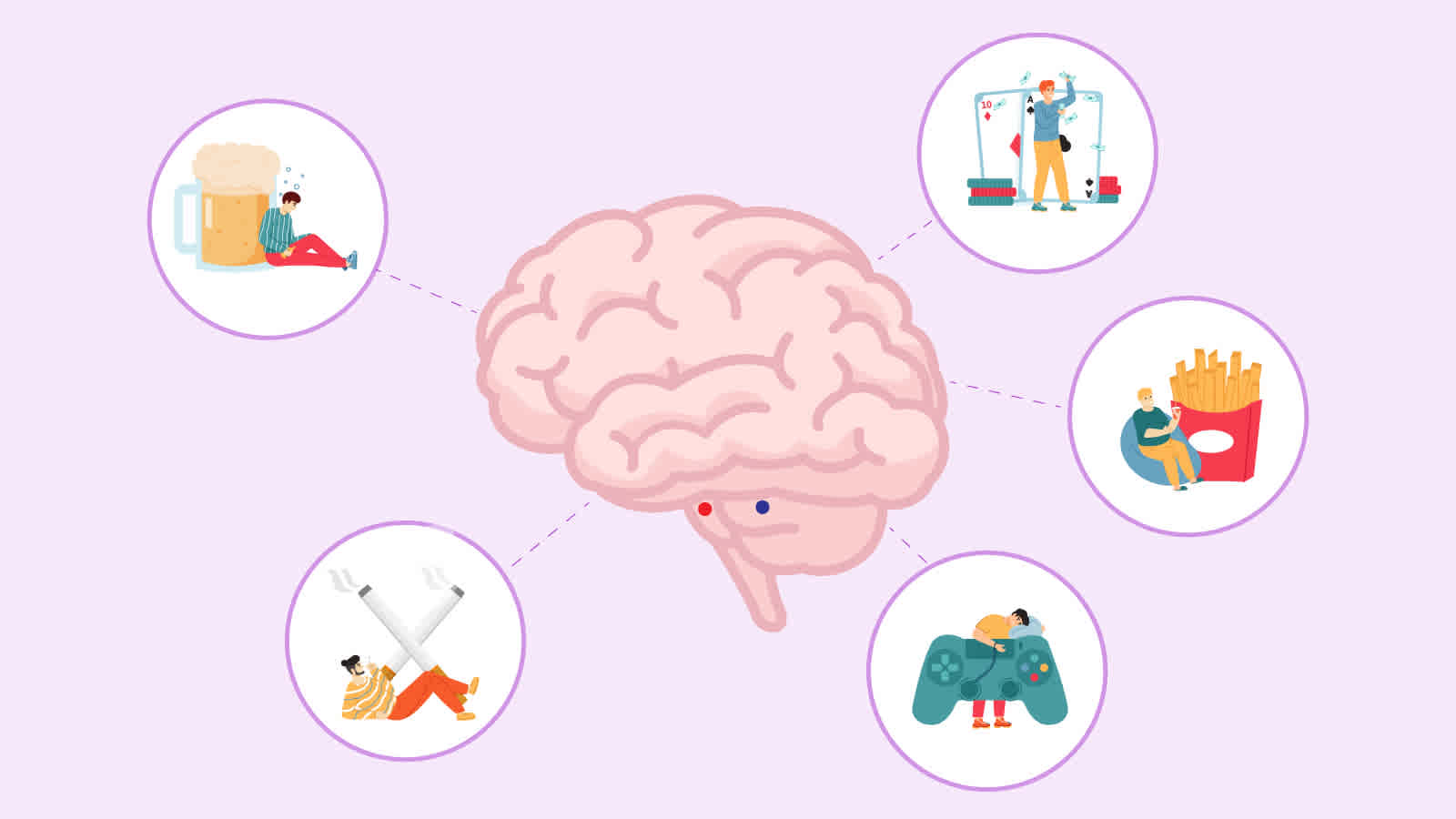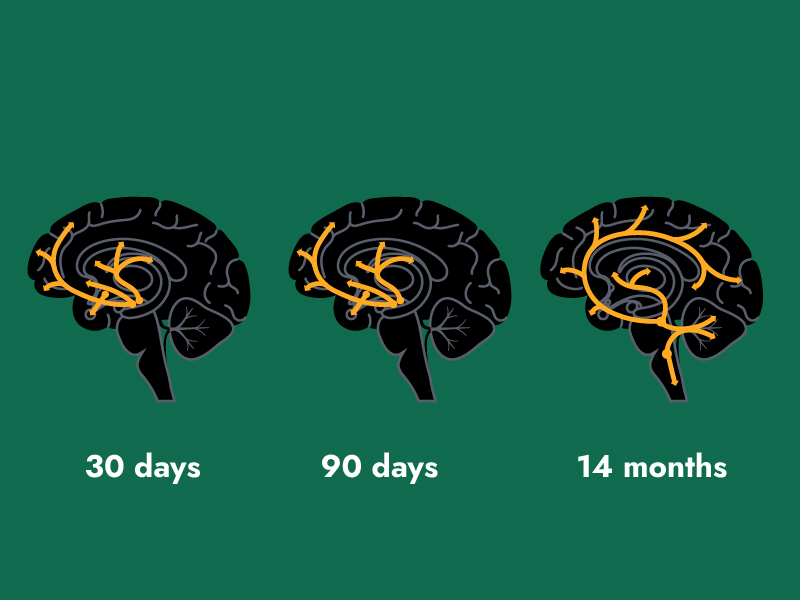Learn / Dopamine and Addiction: What’s the Connection?
Dopamine and Addiction: What’s the Connection?


October 11th, 2022| Clinically Reviewed by
Addiction changes how the brain functions. It especially impacts the brain’s “reward system,” which is largely based on dopamine. This hormone is responsible for our pleasure response, along with other important functions like memory, attention, and mood.
Understanding addiction is an important part of recovery. Knowing there’s a physiological reason for your addiction can relieve some of the shame around it, so you can move forward in your healing journey. And gaining perspective on what’s driving your behavior can help you make lasting change.
A Peek Inside the Brain’s Reward System
We can experience pleasure from all kinds of activities, whether it’s exercise or scrolling social media. Our brain’s reward system is responsible for that feeling, and the desire to seek more of it.
How It Works
Your brain produces a chemical called dopamine. Dopamine is both a hormone and a neurotransmitter, meaning it’s used to send messages between your nerve cells. It’s tied to many functions, from mood regulation and memory to learning. It’s known as the “feel-good” chemical for the large role it plays in pleasure and motivation.
Dopamine is released along different neural pathways when we anticipate and experience something pleasurable.1 As it’s released, it affects dopamine receptors that live along these pathways, resulting in feelings of euphoria or happiness. This is known as the reward circuit.
The reward circuit activates areas of the brain that relate to focus, learning, taking action, and motivation.
The brain builds connections between a stimulus and pleasure that follows.2 Your reward circuit strengthens each time this process occurs. The more frequently it happens, the stronger your response is. Also called a reinforcing effect, it’s involved in how we form habits.3
Cues leading up to pleasure are important. Dopamine makes us pay attention to markers that lead to a reward. This means dopamine activates before you even engage in a pleasurable activity.
This system helped early humans survive by rewarding beneficial behaviors, like eating. When it’s in balance, it allows us to stay focused, motivated, and happy. Dopamine imbalance is linked to mental health issues, like depression, and substance use disorders.
The Reward System at Different Stages of Addiction Recovery
Substances bypass the body’s natural dopamine production by directly flooding the reward system with it. Some substances do this more intensely than others:
Stimulants like cocaine can release up to 10 times the amount of dopamine your body would naturally produce.4
The Early Stages of Substance Use
The first time a substance is used, it creates a direct dopamine response. This intensity of this varies from person to person. According to neurotheology specialist Dr. Cyrus H. McCandless, “you can never accurately predict how much reward you’re going to get.”5
Your brain remembers everything leading up to a reward, so it can repeat the experience. This drives the desire to use more of a substance. As dopamine levels go up, serotonin, which helps us feel satisfied, goes down. This creates a cycle of wanting more while feeling less satiated.
This cycle doesn’t just apply to substance use. Altered dopamine pathways are seen in behavioral addictions,6 including gambling, shopping, and sex.
Building Tolerance
Usually, brain chemistry returns to normal after a dopamine release. But continued substance use surges the brain with dopamine until it becomes overstimulated. Over time, the body wants to balance out, so it shuts down dopamine receptors. As a result, we won’t feel the same high from using the same amount of substances as before. This is how the brain builds tolerance.7
Addiction
The Diagnostic and Statistical Manual of Mental Disorders, Fifth Edition (DSM-5) has 4 criteria for classifying and diagnosing substance use disorders:8
- impaired control
- social impairment
- risky use
- pharmacologic traits
The reward system plays a significant role in these.
Substances artificially change dopamine production. This can signal to the brain that substances are more important than other natural rewards. Eventually, natural rewards become less exciting and the brain learns to value substances9 above all else.
Neuroplasticity, or the brain’s flexibility,10 also plays a part in addiction. We can get used to higher levels of dopamine following prolonged substance use. But an overstimulated brain no longer produces as much of it. Instead, it relies on substances.
Withdrawal
It’s not possible to keep up substance-induced levels of dopamine at all times. Drops in dopamine levels can contribute to withdrawal symptoms:
- depression
- anxiety
- cold sweats
- headaches
- and others
For many people, detox is the first step in the recovery journey. As substances leave your system, your body and brain recalibrate. Low dopamine levels during withdrawal can make this process difficult. But thanks to neuroplasticity, we can nurture our brain chemistry back to normal over time.
Note: Depending on the substance, detox can be life-threatening and shouldn’t be attempted alone.
How Long Does It Take for the Reward System to Recover?
Each person has different levels of dopamine and dopamine receptors.11 The time it takes for the reward system to return to normal after prolonged substance use varies. Factors like the type of substance and level of use will impact recovery time. In general, it takes the brain up to 14 months to recover.

30 days of abstinence
Brain scans show significant improvement and more dopamine receptors in just one month of abstinence from methamphetamine.12
90 days of abstinence
Brain scans in one study showed no significant difference in dopamine receptors following 90 days of abstinence compared to 30 days.13 This indicates that recovery is possible, but it takes time.
14 months of abstinence
The brain’s reward circuit, including dopamine receptor levels, returns to nearly normal after 14 months of abstinence.14
Repairing Your Brain in Recovery
The human brain is capable of amazing things, including the ability to modify and change throughout your lifetime. For many, it’s comforting to know that changes to the brain caused by substance use disorder are reversible. Your brain can repair and heal, if you facilitate its healing.
Rehab can help you do just that. Learn more about RehabPath and its latest announcements, and compare your options in our directory of treatment centers.
Reviewed by Rajnandini Rathod
- Trevor Haynes. (2018, May 1). Dopamine, Smartphones & You: A battle for your time. Science in the News. https://sitn.hms.harvard.edu/flash/2018/dopamine-smartphones-battle-time/ [↩]
- Martinez, J. L., & Derrick, B. E. (1996). Long-term potentiation and learning. Annual Review of Psychology, 47, 173–203. https://doi.org/10.1146/annurev.psych.47.1.173 [↩]
- Volkow, N. D., Fowler, J. S., Wang, G.-J., Swanson, J. M., & Telang, F. (2007). Dopamine in drug abuse and addiction: Results of imaging studies and treatment implications. Archives of Neurology, 64(11), 1575–1579. https://doi.org/10.1001/archneur.64.11.1575 [↩]
- The brain in recovery. (2017, January 28). Recovery Research Institute. https://www.recoveryanswers.org/recovery-101/brain-in-recovery/ [↩]
- Misunderstanding dopamine: Why the language of addiction matters | Cyrus McCandless | TEDxPortsmouth. (n.d.). Retrieved September 30, 2022, from https://www.youtube.com/watch?v=aqXmOb_fuN4 [↩]
- Grant, J. E., Potenza, M. N., Weinstein, A., & Gorelick, D. A. (2010). Introduction to behavioral addictions. The American Journal of Drug and Alcohol Abuse, 36(5), 233–241. https://doi.org/10.3109/00952990.2010.491884 [↩]
- Volkow, N. D., Wang, G.-J., Fowler, J. S., Tomasi, D., Telang, F., & Baler, R. (2010). Addiction: Decreased reward sensitivity and increased expectation sensitivity conspire to overwhelm the brain’s control circuit. BioEssays : News and Reviews in Molecular, Cellular and Developmental Biology, 32(9), 748–755. https://doi.org/10.1002/bies.201000042 [↩]
- McNeely, J., & Adam, A. (2020, October). Table 3, dsm-5 diagnostic criteria for diagnosing and classifying substance use disorders [abc] [Text]. https://www.ncbi.nlm.nih.gov/books/NBK565474/table/nycgsubuse.tab9/ [↩]
- MIT scientists discover fundamental rule of brain plasticity. (n.d.). MIT News | Massachusetts Institute of Technology. Retrieved September 30, 2022, from https://news.mit.edu/2018/mit-scientists-discover-fundamental-rule-of-brain-plasticity-0622 [↩]
- Castrellon, J. J., Seaman, K. L., Crawford, J. L., Young, J. S., Smith, C. T., Dang, L. C., Hsu, M., Cowan, R. L., Zald, D. H., & Samanez-Larkin, G. R. (2019). Individual differences in dopamine are associated with reward discounting in clinical groups but not in healthy adults. Journal of Neuroscience, 39(2), 321–332. https://doi.org/10.1523/JNEUROSCI.1984-18.2018 [↩]
- J R Beveridge, T., R Smith, H., Nader, M., & Porrino, L. (2008). Abstinence from Chronic Cocaine Self-Administration Alters Striatal Dopamine Systems in Rhesus Monkeys. Neuropsychopharmacology: Official Publication of the American College of Neuropsychopharmacology, 34(5). https://doi.org/10.1038/npp.2008.135 [↩]
- National Institute on Drug Abuse. “Treatment and Recovery.” National Institute on Drug Abuse, –, https://nida.nih.gov/publications/drugs-brains-behavior-science-addiction/treatment-recovery. [↩]
- J R Beveridge, T., R Smith, H., Nader, M., & Porrino, L. (2008). Abstinence from Chronic Cocaine Self-Administration Alters Striatal Dopamine Systems in Rhesus Monkeys. Neuropsychopharmacology: Official Publication of the American College of Neuropsychopharmacology, 34(5). https://www.researchgate.net/figure/Representative-autoradiograms-of-3H-SCH-23390-binding-to-D1-receptors-top-panel-and_fig1_23234006 [↩]
- “The Brain in Recovery.” Recovery Research Institute, 28 Jan. 2017, https://www.recoveryanswers.org/recovery-101/brain-in-recovery/. [↩]
Return to Resource Library
Our Promise
How Is RehabPath Different?
We believe everyone deserves access to accurate, unbiased information about mental health and addiction. That’s why we have a comprehensive set of treatment providers and don't charge for inclusion. Any center that meets our criteria can list for free. We do not and have never accepted fees for referring someone to a particular center. Providers who advertise with us must be verified by our Research Team and we clearly mark their status as advertisers.








